Circumpolar constellations are constellations that are (largely speaking) visible all night and throughout the year.
Many non-astronomers believe we see the same stars and constellations every night of the year.
They think the stars are just, well, the stars, and twinkle away above our heads like tiny fairy lights decorating the ceiling of the world.
Perhaps you did yourself, before you took your first steps in the hobby.
Why do people believe this? Perhaps it’s because they spend so little time looking at the night sky that they don’t see the changes.
A quick glance at the stars while you’re walking the dog, pushing a shopping trolley to your car or walking home from the pub will not be enough to reveal that the sky changes all the time.
Read our pick of the best constellations season by season
Changing skies, changing constellations

Everyone knows that the Sun rises, crosses the sky and then sets because they see it with their own eyes, every day (weather permitting!)
This is because Earth is spinning in space, like a top, and that rotation causes the Sun to move across the sky each day.
This same rotation causes the stars and constellations and other celestial objects to rise and move across the sky during the night, and eventually set.
This stellar motion is obvious if you go out on a clear night, pick a bright star shining low in the sky, mentally mark its position in relation to any nearby trees, buildings or landmarks, then go away and do something else for half an hour.
When you look again you’ll see that your chosen star has moved in relation to its surroundings, and might now be behind or on the other side of the tree or chimney you saw it close to before.
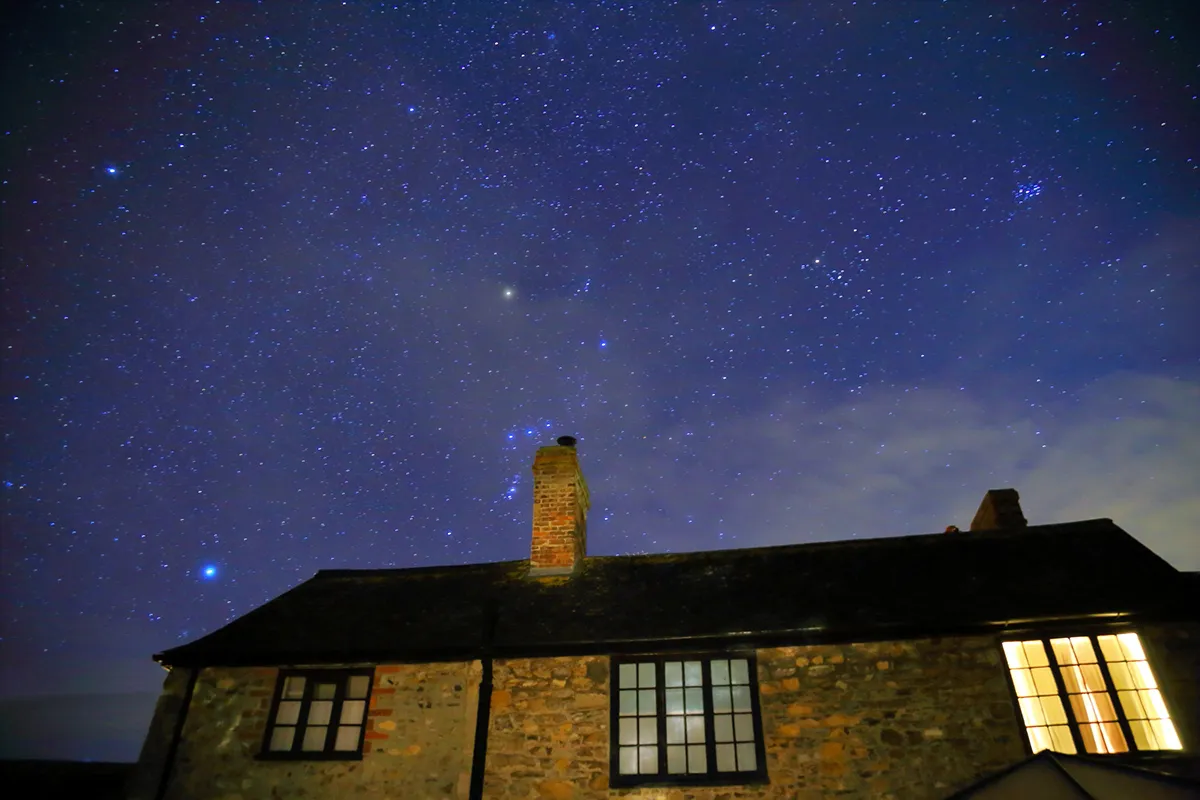
Of course the star hasn’t moved, the Earth itself has moved, spinning on its axis, causing the star to appear to change position as it sweeps in a giant circle around the only star in the sky that doesn’t change its position: Polaris, the North Star.
That motion is quite fast, you can see it for yourself in just a few minutes, but the sky changes in another way much more slowly too.
As the Earth moves around the Sun our view of the Universe changes, just as the view through your car window changes as you drive around a roundabout.
As the days and weeks pass the constellations we can see in the sky change.
They first appear in the east in the morning, spend a few months visible in the sky and then fade away again, dropping behind the western horizon after sunset.
This is one reason why stargazing is such a fascinating hobby: each season has its own sky, with its own unique and fascinating constellations.
Constellations that are (mostly) always visible
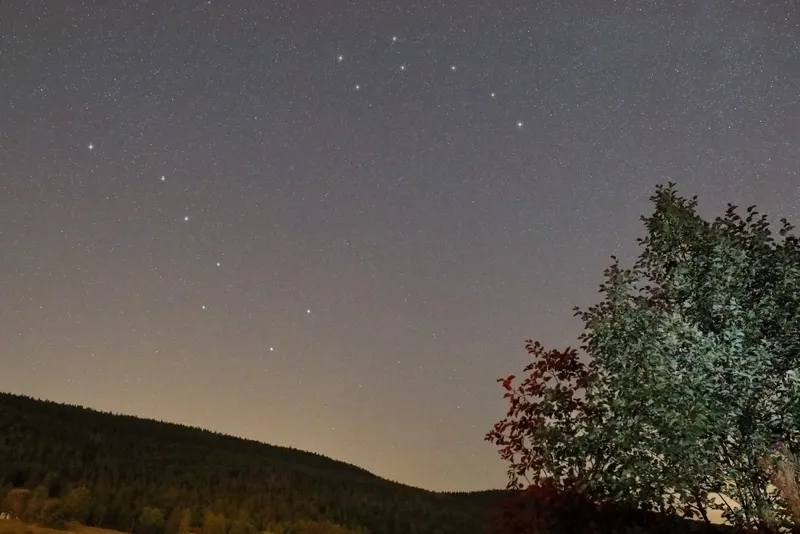
There are a handful of stars and constellations that are visible all night and all through the year too, if you live far enough north or south.
These are the circumpolar constellations, so called because they are so close to the celestial poles that they are never lost from view.
Although their orientation changes through the night and through the year too, circumpolar constellations are always visible.
While they might see parts of other constellations dipping briefly behind the horizon for a while, for most northern hemisphere observers the only truly circumpolar constellations are Cassiopeia, Cepheus, Draco, Ursa Major and Ursa Minor, so let’s look at those, before taking a look at which constellations are circumpolar for southern hemisphere observers too.
Northern hemisphere circumpolar constellations
- Cassiopeia
- Cepheus
- Draco
- Ursa Major
- Ursa Minor
Cassiopeia (the Queen)

One of the most popular constellations in the northern sky, the five brightest stars of Cassiopeia form a distinctive W-shaped asterism that is very obvious to the naked eye.
Cassiopeia represents an Ethiopian queen who unwisely claimed that she was more beautiful than the gods.
As punishment those gods hurled her up into the sky, and now she has to spend half the year clinging very unglamourously to her throne to avoid falling out.
Use Cassiopeia to help you locate the Andromeda Galaxy in the night sky.
Cepheus (The King)
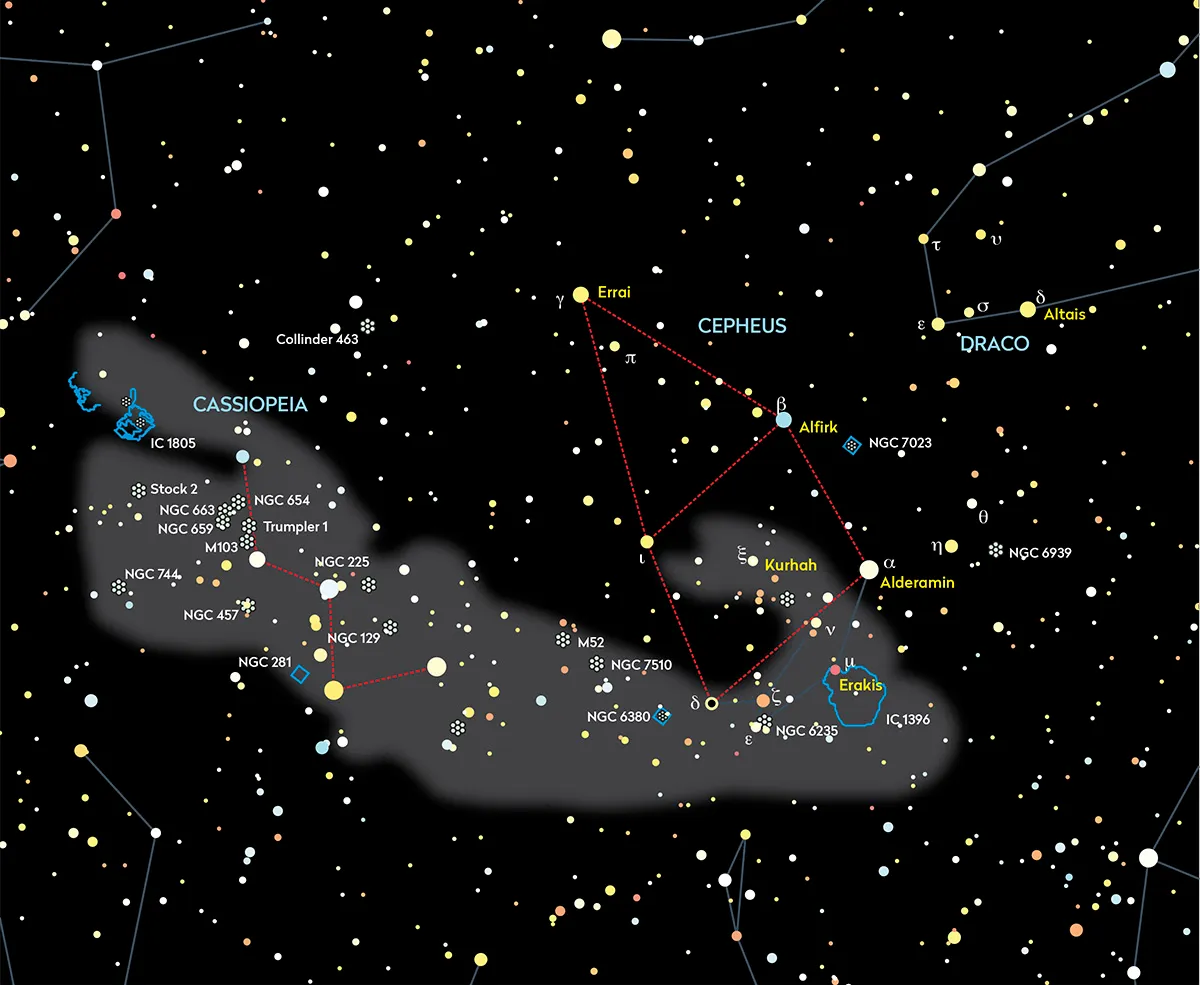
Join up the five brightest stars of this faint constellation and you’ll see what looks very much like a child’s drawing of a house, complete with pointed roof.
Named after Cassiopeia’s husband, Cepheus is best known for the star Delta Cephei, a variable star which gave its name to the class of stars known as Cepheid Variables, which astronomers use to accurately measure distances in space.
See if you can spot star Alderamin in the constellation.
Draco (The Dragon)

One of the oldest constellations in the sky, Draco is also one of the hardest to find because it has no bright stars and is essentially just a wiggly line of faint stars curling between the two bears, Ursa Major and Ursa Minor.
Its 4th magnitude star Thuban was the pole star 30,000 years ago.
Ursa Major (The Great Bear)
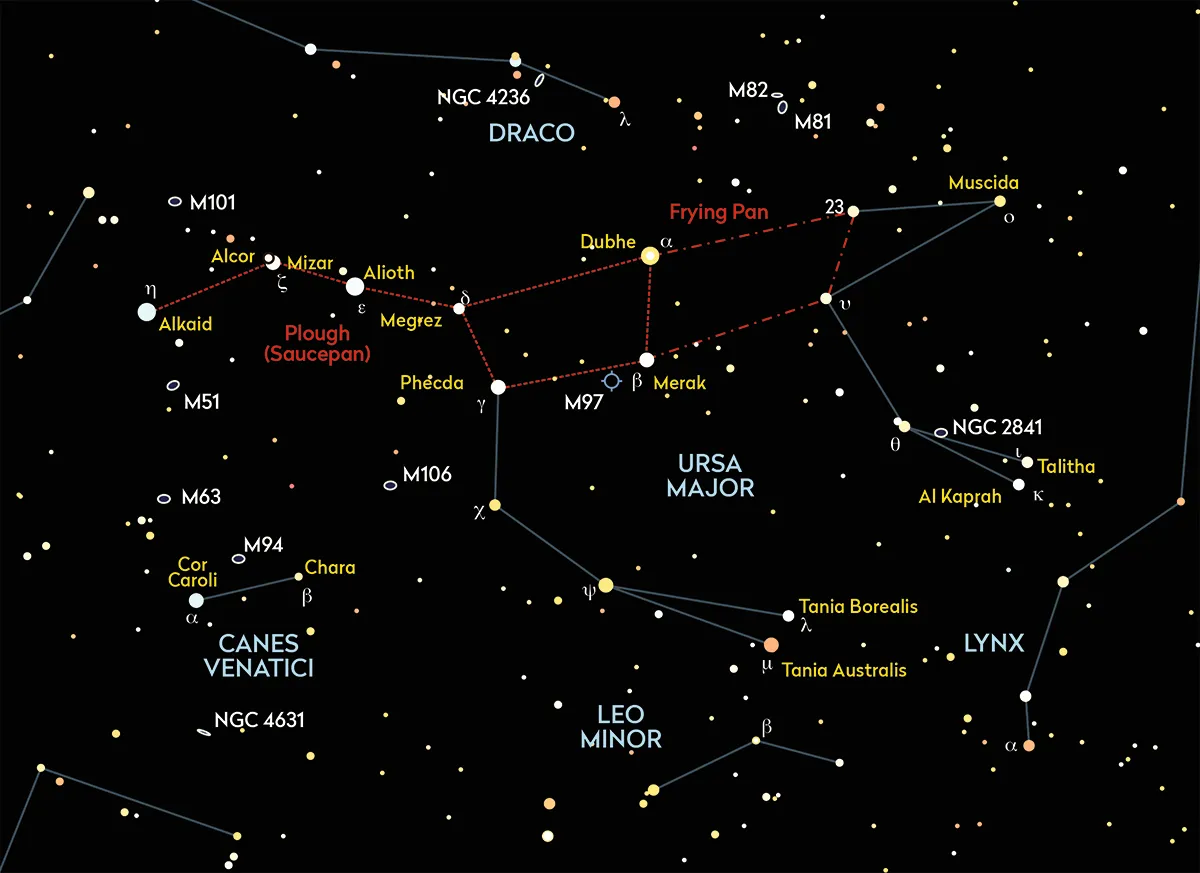
Ask non-astronomers to name a constellation and many, if not most, will confidently say "The Big Dipper", unaware that this striking pattern of seven stars is in fact an asterism, a shape within the actual much larger constellation of Ursa Major, the Great Bear.
There are many beautiful galaxies within Ursa Major, including M81 and M82.
Can you spot star Muscida, the nose of the Great Bear?
Ursa Minor (The Little Bear)
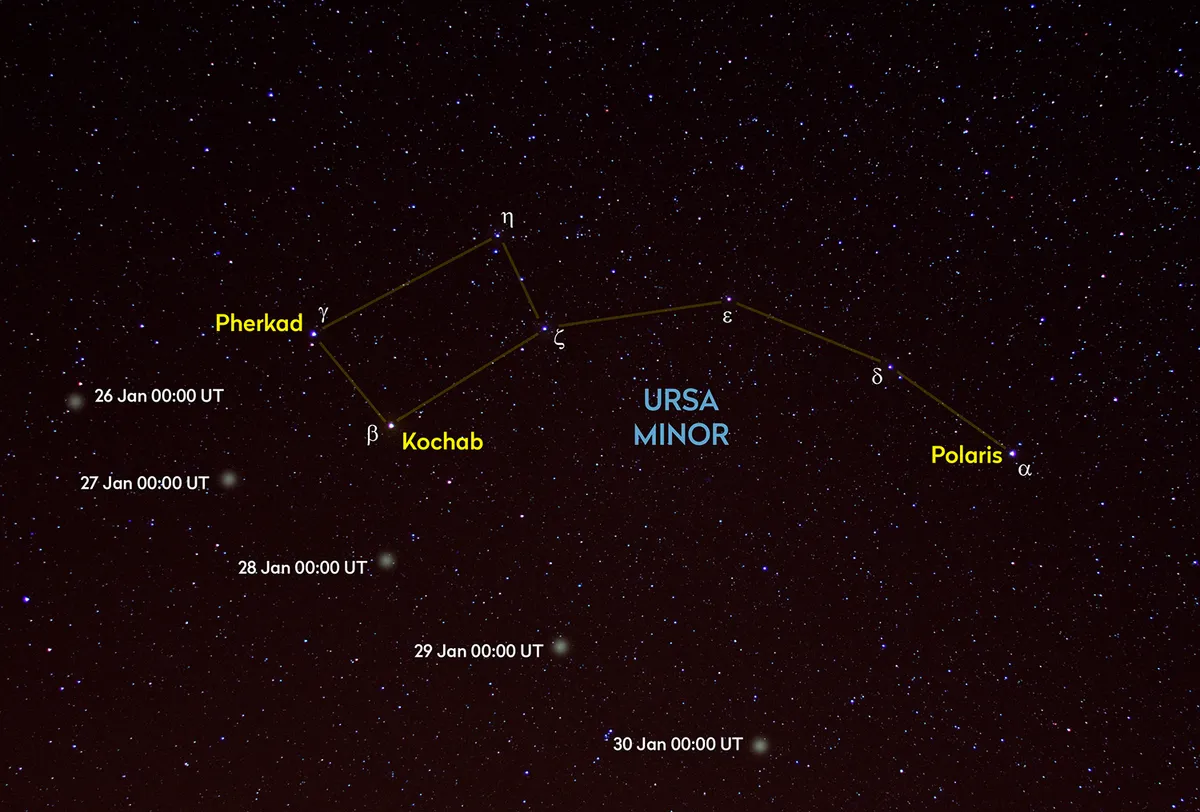
The Little Bear, Ursa Minor is the most circumpolar constellation of all, because it is the closest to the pole.
In fact, the tip of its tail is marked by Polaris, the famous Pole or North Star, the star every other star wheels around through the night.
Southern hemisphere circumpolar constellations
- Carina
- Centaurus
- Crux
For more advice, read our guide to the southern hemisphere night sky and a history of the southern hemisphere constellations
Carina (The Keel)
Carina is often called the 'Orion of the Southern Skies'. It was once part of Argo Navis, which was the largest constellation in the entire sky and represented the Argo, the ship which carried Jason and his heroic Argonauts on their epic quest.
Carina contains Canopus, the second brightest star in the sky, and the beautiful Eta Carina nebula.
Centaurus (The Centaur)
Named after a mythical half man half horse creature, Centaurus contains Alpha Centauri, the closest star system to our own.
The faintest member of the system, the red dwarf Proxima Centauri, is actually the closest star to the Sun, just 4.2 light years away.
Centaurus also contains the finest globular star cluster in the sky, Omega Centauri.
Crux (The Southern Cross)
Crux is the smallest constellation in the whole sky, but one of the most important, as it contains the famous Southern Cross, an asterism that points the way to the southern celestial pole in the same way the stars of Ursa Major point to the northern pole.
Crux also contains the beautiful Jewel Box star cluster and the dark nebula known as the Coalsack Nebula.

